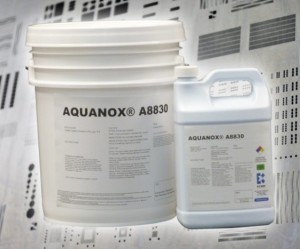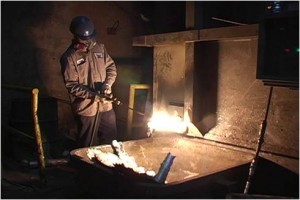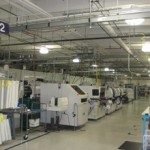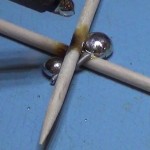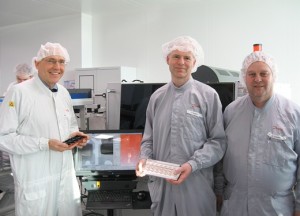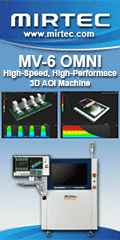Dr. Mike Bixenman , KYZEN Corporation
Introduction
The age of electronics has created innovative technologies that improve living standards, communications, transportation, automation, health, and business administration. These advances are made possible from technology advances using smaller components and high density board designs that allow information to be processed at increasing rates.
Miniaturization at all levels opens the pathway for assembly residues to form a conductive cell between two points on the printed circuit board. During the soldering process, flux residues underfill the bottom side of leadless components. Removing these residues post soldering has become increasingly difficult. As a result, higher density board designs increase reliability risks, which are commonly mitigated by cleaning all flux residues and ionic contamination on the surface and under components on the printed circuit assembly.
Ultrasonic cleaning in combination with cleaning agents matched to the soil is a proven technology for removing soils entrapped under leadless components. One concern is that ultrasonic energy has the potential to damage printed circuit boards by breaking wire bonds, eroding circuit traces, and fracturing solder connections. These concerns have been addressed by selecting the appropriate frequency and amplitude.
5-CLEANING FORCES
Five forces that directly influence the cleaning properties of flux residue from the printed circuit assembly are the solder flux, heat exposure, component gap, cleaning agent, and cleaning equipment (Figure 1). Variations in any of these factors can and does influence the cleaning rate.
Soldering Flux
The cleaning process is in place to remove unwanted contaminants. The most important factor is the nature of the contaminant and the forces needed to dissolve or displace the soil. Solubility testing provides valuable insight into the forces needed to dissolve the soil. Matching the cleaning agent to the soil increases the rate of removal and the ability to remove soils under the bottom side of the component.
Miniaturization and the move to lead-free alloys created new demands on flux compositions. Smaller pad dimensions results in less solder paste needed to make the connection. As the volume of solder paste decreases, the levels of flux available to remove metal oxides, wet, and prevent re-oxidation during the soldering process is less. High yields require thermally stable resins formulated into the flux composition to prevent oxidation and burn off during soldering.
The variability of soils and the flux compositions impacts the cleaning process. Thermally stable flux packages and the need for higher reflow temperatures renders harder to dissolve soils. As soils become more difficult to displace, the importance of cleaning energy that can move the cleaning agent to soil is critical for removing the soil under the bottom side of the component.
Heat Exposure
Lead-Free SAC alloys require increased peak reflow temperatures in the range of 30-50°C higher than what was needed for tin-lead eutectic. Additionally, longer soak profiles are needed to improve bottom termination yields. Higher temperatures deplete solvent rich zones (Figure 1). As the solvents within the resin structure depletes, the residue hardens and can burn, oxidize and cross-link.
Flux compositions built for eutectic tin-lead solder have consistently improved with time. Improved aqueous cleaning agents opened the process window. This allowed assemblers to build the top and bottom side of the board using multiple reflow cycles before cleaning assemblies.
The flux properties designed for SAC lead-free alloys are very different. Increased heat exposure hardens the residue while changing the soil properties. This change tightens the process window and requires better understanding. Over exposure to heat changes the solubility properties and potentially creates a soil that is not cleanable.
Component Gap
Component miniaturization decreases the spacing between conductors. During solder reflow, flux under fills the bottom side of the component (Figure 2). The distance from the board surface to the bottom side of leadless components is consistently less than 2 mils. For cleaning to occur, the cleaning agent must penetrate, wet, dissolve, and create a flow channel.
The tighter the component is to the board surface, the greater the need for mechanical systems capable of moving the cleaning agent to the soil. The mechanical effect of ultrasonic energy rapidly erodes residue at the periphery while moving the cleaning agent to the soil bound under the component.
Cleaning Agent
The critical differentiator for removing higher molecular weight flux residues is the cleaning agent. Cleaning agents designed for ultrasonic systems need to be homogenous (single phase compositions). The cleaning agent must be compatible with the materials of construction and formulated for use with ultrasonics.
Aqueous cleaning agents have progressively become the cleaning agents of choice for cleaning electronic assemblies. Multi-faceted flux compositions are composed of oil loving and water solving solutes. For spray-in-air systems, some aqueous cleaning agents were designed to form a solvent layer and water layer. Water carried solvent droplets while improving the dissolution rate on resin-based flux residues. This feature improved the cleaning rate at lower concentration levels.
Aqueous cleaning agents designed for ultrasonic cleaning equipment requires a range of ingredients that dissolve hydrophobic (oil loving) resin structures and water loving ionic contaminants. To accomplish the desired properties, aqueous cleaning agents are designed as ready to use compositions. At the designed cleaning temperature, the cleaning agent is clear with no cloudiness or phase composition.
The best case aqueous engineered cleaning agents are formulated with materials that match up to a wide range of flux technologies. Designed with low solution viscosity, the cleaning agent rapidly degasses and cavitates. The solution is further designed to achieve the desired cavitation at the temperatures in the range of 60-70°C.
Cleaning Machine
Ultrasonic cleaning energy fell out of favor for cleaning high reliability electronic assemblies. Assemblers were concerned with resonant damage to wire bonds and metallized traces. Ultrasonic equipment innovations in wave output, pulse, and frequency sweep decreased pressure and the size of the bubble before collapse. Modulating the frequency reduced impinging forces to the circuit assembly by changing the speed and magnitude of the bubble collapse.
Frequencies higher than 80 KHz provide less stress on metallization, which greatly reduces the probability of damage to electronic components. The output frequency can be modulated and adjusted to the desired energy effects. Cleaning agents that match up the soil and designed to cavitate at the desired frequency levels opens the process window.
Important process factors include wash time, wash temperature, and part placement (fixturing). Increased wash time is required to remove flux residues from under bottom termination components. With reduced spacing between conductors, flux residues underfill the bottom side of the component (Figure 3). Cleaning takes place from the outside-in. As the cleaning process breaks through the residue dam under the component, the remaining residue under the component cleans at increased rates.
Wash temperature in the range of 55-70°C improves flux residue removal and cavitation. Most flux residues dissolve better at higher processing temperatures. Temperature effects must be qualified in that some flux residues clean better at lower processing temperatures. The best match temperature can be easily quantified from residue solubility studies completed by the cleaning agent provider. Higher processing temperatures typically improve cavitation. With increasing wash temperatures, fluid viscosity typically drops, which improves the diffusion of gases within the liquid.
Maximizing the Ultrasonic Cleaning Process
The best electronic assembly cleaning processes take into account the five cleaning forces.
Selecting a solder paste or flux with a cleanable residue opens the process window.
Pay close attention to the soldering profile. Excessive heat exposure can burn/oxidize the residue rendering a difficult to clean residue.
When cleaning boards populated with bottom termination components, clean soon after the solder process.
Select a cleaning agent that is matched to the soil. Ask your cleaning agent vendor for solubility data and pay close attention to the data when selecting the cleaning agent.
The cleaning agent must be designed for ultrasonic processing.
When the five forces are closely aligned, the cleaning process will meet the process need.












